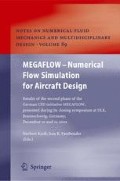Summary
The 3D Navier-Stokes solver TAU is coupled with linear stability analysis methods in order to predict flows including transition due to Tollmien-Schlichting (TS) and crossflow (CF) instabilities. The new simulation capability is investigated for an airfoil and compared with data of 2D boundary layer methods that include transition prediction based on a well-known envelope method and with experiments. The results indicate the levels of grid and residual convergence needed for accurate transition prediction. First applications of transition prediction in 3D for a 1:6 prolate spheroid are discussed. It is shown that transition calculations for fully 3D flows are numerical feasible and yield physically reasonable results for moderate angles of attack.
Access this chapter
Tax calculation will be finalised at checkout
Purchases are for personal use only
Preview
Unable to display preview. Download preview PDF.
References
T. Gerhold, M. Galle, O. Friedrich, J. Evans: “Calculation of Complex Three-Dimensional Configurations Employing the DLR-TAU-Code”, AIAA paper 97-0167 (1997).
H.-W. Stock, E. Degenhart: “A Simplified en Method for Transition Prediction in Two-Dimensional, Incompressible Boundary Layers”, Z. Flugwiss. Weltraumforsch. 13 (1989) pp. 16–30.
G. Casalis, D. Arnal: “Database method — Development and validation of the simplified method for pure crossflow instability at low speed”, ELFIN II Technical Report No. 145, ONERA CERT, (1996).
H.-W. Stock, H.P. Horton: Ein Integralverfahren zur Berechnung dreidimensionaler, laminarer, kompressibler, adiabater Grenzschichten. Z. Flugwiss. Weltraumforsch. 9, Heft 2(1985) pp. 101–110.
D.M. Somers: “Design and Experimental Results for a Natural-Laminar-Flow Airfoil for General Aviation Applications”, NASA Technical Paper 1861 (1981).
M. Drela: XFOIL: “An Analysis and Design System for Low Reynolds Number Airfoils”, in T.J. Mueller (Editor): Low Reynolds Number Aerodynamics, Springer Verlag (1989) pp. 1–12.
H.U. Meier, H.-P. Kreplin: “Experimental Investigation of the Boundary Layer Transition and Separation on a Body of Revolution”, Z. Flugwiss. Weltraumforsch. 4, Heft 2 (1980) pp.65–71.
H.U. Meier, H.-P. Kreplin: “Boundary Layer Separation Due to “weak” and “strong” Viscous-Inviscid Interaction on an Inclined Body of Revolution”, In. AFWAL Viscous and Interacting Flow Field Effects (1984) pp. 79–96.
F. Menter, H.-P. Kreplin: “Stability Analysis with the e N-Method for the Prolate Spheroid at Zero Angle of Attack”, IB222-88 A28, DFVLR-AVA Göttingen (1988).
D. Arnal: Boundary Layer Transition: “Predictions based on Linear Theory”, AGARD-VKI Special Course on “Progress in Transition Modelling”, AGARD Report 793 (1994).
H. Schlichting, K. Gersten: “Boundary Layer Theory”, 8th ed. 2000, Springer, Berlin, Heidelberg, New York (2001).
H.-W. Stock: “Determination of Length Scales in Algebraic Turbulence Models for Navier-Stokes Methods”, AIAA Journal, Vol. 27, No. 1 (1989) pp. 5–14.
H.-W. Stock, W. Haase: “Feasibility Study of e N Transition Prediction in Navier-Stokes Methods for Airfoils”, AIAA Journal, Vol. 37, No. 10, October 1999.
I.A. Sadarjoen, T. van Walsum, A.J.S. Hin, F.H. Post: “Particle Tracing Algorithms for 3D Curvilinear Grids”, in G. Nielson, H. Müller, H. Hagen (Editors): Scientific Visualization — Overviews, Methologies and Techniques, IEEE (1997) pp. 299–332.
C. Nebel, R. Radespiel, T. Wolf: “Transition prediction for 3D flows using a Reynolds-averaged Navier-Stokes code and N-factor methods”, AIAA-Paper No. 2003-3593, (2003).
Centaursoft: Centaur™. http://www.centaursoft.com.
K. Maruhn: “Druckverteilungen an elliptischen Rümpfen und in ihrem Außnraum”, Jahrbuch der deutschen Luftfahrtforschung (1941) pp. 135–147.
Author information
Authors and Affiliations
Editor information
Editors and Affiliations
Rights and permissions
Copyright information
© 2005 Springer-Verlag Berlin Heidelberg
About this paper
Cite this paper
Nebel, C., Radespiel, R., Haas, R. (2005). Transition Prediction for 2D and 3D Flows using the TAU-Code and N-Factor Methods. In: Kroll, N., Fassbender, J.K. (eds) MEGAFLOW - Numerical Flow Simulation for Aircraft Design. Notes on Numerical Fluid Mechanics and Multidisciplinary Design (NNFM), vol 89. Springer, Berlin, Heidelberg . https://doi.org/10.1007/3-540-32382-1_18
Download citation
DOI: https://doi.org/10.1007/3-540-32382-1_18
Publisher Name: Springer, Berlin, Heidelberg
Print ISBN: 978-3-540-24383-0
Online ISBN: 978-3-540-32382-2
eBook Packages: EngineeringEngineering (R0)

